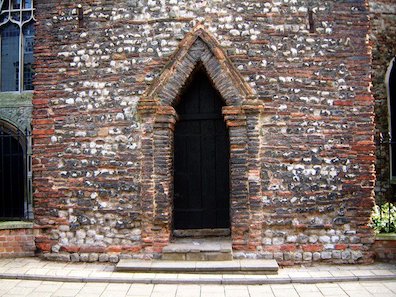-396 225.jpg) The Medieval Period, or Middle Ages, lasted from the fall of the Roman Empire in the 5th century AD until around the 15th century. During this time Colchester saw an Anglo-Saxon settlement, Viking and Norman Invasion, and a thriving cloth and weaving industry become established. Colchester regained its position as one of the most important towns in the country, receiving its royal charter in 1189
The Medieval Period, or Middle Ages, lasted from the fall of the Roman Empire in the 5th century AD until around the 15th century. During this time Colchester saw an Anglo-Saxon settlement, Viking and Norman Invasion, and a thriving cloth and weaving industry become established. Colchester regained its position as one of the most important towns in the country, receiving its royal charter in 1189
Many of Colchester's most notable and important historic buildings were built during this period, including Colchester Castle, St Botolph's Priory, St John's Abbey, as well as settlement in the Dutch Quarter and city centre in general.
Anglo-Saxon Colchester
From around AD 450 the Anglo Saxons started settling in England, but they seemed to have little interest in living in towns and is is thought the s ettlement at Colchester went into decline. Around AD 886 the town came under Viking control, but by AD917 they had been driven our by the Saxon king Edward the Elder. For the next 150 years the town flourished, although little remains in Colchester from this period, the notable exception to this rule is the impressive tower of Trinity Church with its distinctive Saxon arrowhead doorway, which dates back to this time.
ettlement at Colchester went into decline. Around AD 886 the town came under Viking control, but by AD917 they had been driven our by the Saxon king Edward the Elder. For the next 150 years the town flourished, although little remains in Colchester from this period, the notable exception to this rule is the impressive tower of Trinity Church with its distinctive Saxon arrowhead doorway, which dates back to this time.
The Normans in Colchester
In 1066 the Normans invaded, and with Colchester thriving they put the town under the protection of Eudo the Steward who began work on Colchester Castle in the late 1060s. Work also commenced on a number of significant religious foundations: St. Botolph's Priory, the first Augustinian house in England, and St John's Abbey. Today the impressive ruins of the great church at St Botolph's only hint at the scale of the medieval priory, while at St John.jpeg) 's Abbey some long sections of the precinct wall and the later Tudor gatehouse survive.
's Abbey some long sections of the precinct wall and the later Tudor gatehouse survive.
Older than both the Castle and the Priory, St Helen's Chapel can be found in Colchester's historic Dutch Quarter. Like the Castle it is built on Roman foundations, however in the chapel's case on the corner of the Roman Theatre. Named after St Helena, the patron saint of Colchester, St Helen's Chapel is now home to the Greek Orthodox Church in Colchester and is usually open to look around.
Medieval Colchester Today
In 1348 at least a quarter of Colchester's population died of the plague as the Black Death swept through Western Europe. The town not only survived the crisis but soon experienced a new golden age as trade recovered and the local cloth industry boomed.
Colchester Castle today is a museum displaying the riches of Colchester's past, within the walls of the largest Norman keep ever built. Colchester City Centre itself has many historic sites to explore, and you can download the Ancient Colchester App to see these sites comes to life.




-396 225.jpg) The Medieval Period, or Middle Ages, lasted from the fall of the Roman Empire in the 5th century AD until around the 15th century. During this time Colchester saw an Anglo-Saxon settlement, Viking and Norman Invasion, and a thriving cloth and weaving industry become established. Colchester regained its position as one of the most important towns in the country, receiving its royal charter in 1189
The Medieval Period, or Middle Ages, lasted from the fall of the Roman Empire in the 5th century AD until around the 15th century. During this time Colchester saw an Anglo-Saxon settlement, Viking and Norman Invasion, and a thriving cloth and weaving industry become established. Colchester regained its position as one of the most important towns in the country, receiving its royal charter in 1189 ettlement at Colchester went into decline. Around AD 886 the town came under Viking control, but by AD917 they had been driven our by the Saxon king Edward the Elder. For the next 150 years the town flourished, although little remains in Colchester from this period, the notable exception to this rule is the impressive tower of
ettlement at Colchester went into decline. Around AD 886 the town came under Viking control, but by AD917 they had been driven our by the Saxon king Edward the Elder. For the next 150 years the town flourished, although little remains in Colchester from this period, the notable exception to this rule is the impressive tower of .jpeg) 's Abbey some long sections of the precinct wall and the later
's Abbey some long sections of the precinct wall and the later 

